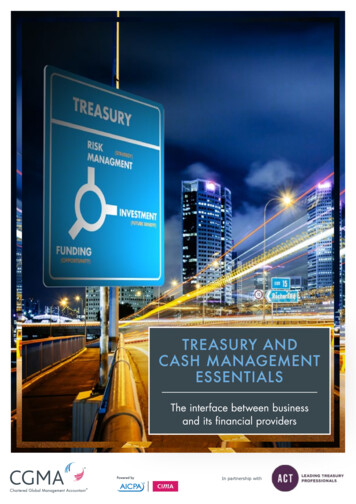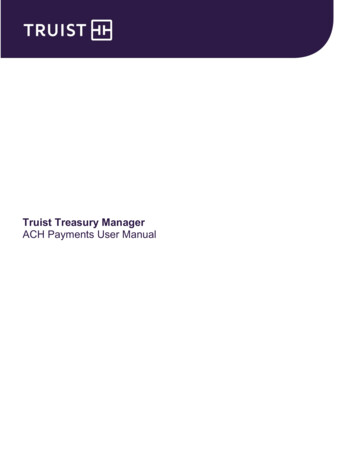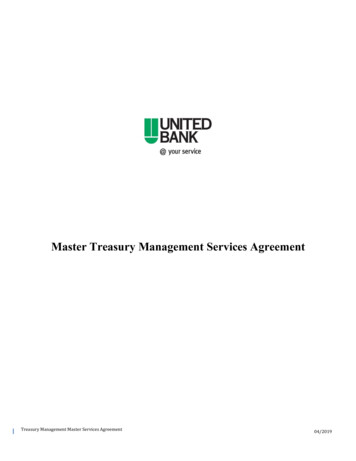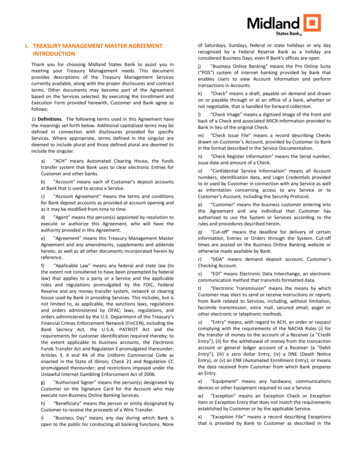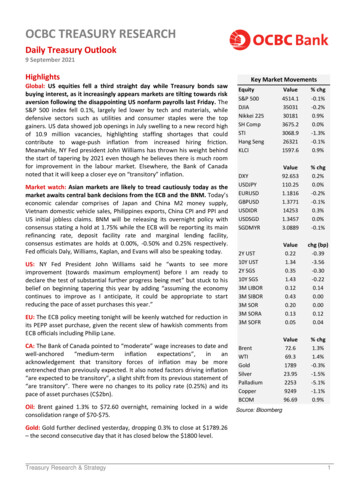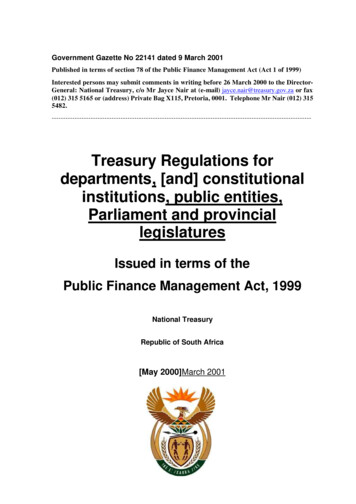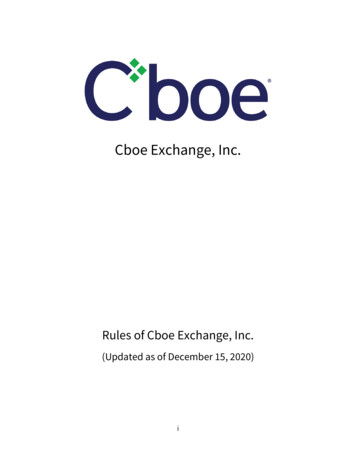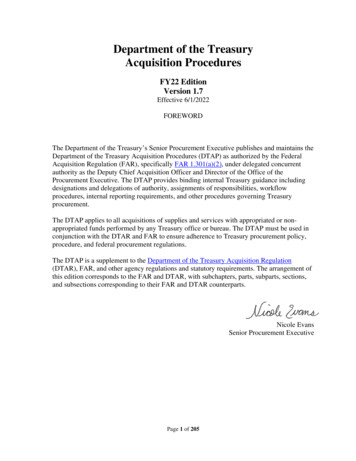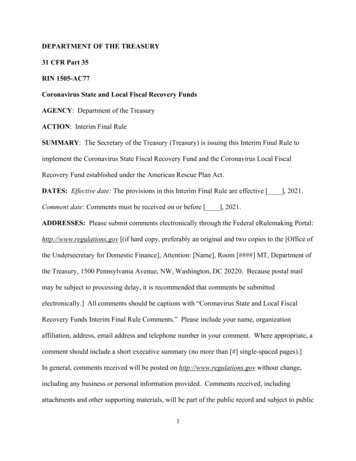
Transcription
DEPARTMENT OF THE TREASURY31 CFR Part 35RIN 1505-AC77Coronavirus State and Local Fiscal Recovery FundsAGENCY: Department of the TreasuryACTION: Interim Final RuleSUMMARY: The Secretary of the Treasury (Treasury) is issuing this Interim Final Rule toimplement the Coronavirus State Fiscal Recovery Fund and the Coronavirus Local FiscalRecovery Fund established under the American Rescue Plan Act.DATES: Effective date: The provisions in this Interim Final Rule are effective [ ], 2021.Comment date: Comments must be received on or before [ ], 2021.ADDRESSES: Please submit comments electronically through the Federal eRulemaking Portal:http://www.regulations.gov [(if hard copy, preferably an original and two copies to the [Office ofthe Undersecretary for Domestic Finance], Attention: [Name], Room [####] MT, Department ofthe Treasury, 1500 Pennsylvania Avenue, NW, Washington, DC 20220. Because postal mailmay be subject to processing delay, it is recommended that comments be submittedelectronically.] All comments should be captions with “Coronavirus State and Local FiscalRecovery Funds Interim Final Rule Comments.” Please include your name, organizationaffiliation, address, email address and telephone number in your comment. Where appropriate, acomment should include a short executive summary (no more than [#] single-spaced pages).]In general, comments received will be posted on http://www.regulations.gov without change,including any business or personal information provided. Comments received, includingattachments and other supporting materials, will be part of the public record and subject to public1
disclosure. Do not enclose any information in your comment or supporting materials that youconsider confidential or inappropriate for public disclosure.FOR FURTHER INFORMATION CONTACT:[Name], [Title], [Office], 202-622-[####], or [Name], [Title], [Office], 202-622-[####].SUPPLEMENTARY INFORMATION:I.Background InformationA. OverviewSince the first case of coronavirus disease 2019 (COVID-19) was discovered in theUnited States in January 2020, the disease has infected over 32 million and killed over 575,000Americans. 1 The disease has impacted every part of life: as social distancing became anecessity, businesses closed, schools transitioned to remote education, travel was sharplyreduced, and millions of Americans lost their jobs. In April 2020, the national unemploymentrate reached its highest level in over seventy years following the most severe month-over-monthdecline in employment on record. 2 As of April 2021, there were still 8.2 million fewer jobs thanbefore the pandemic. 3 During this time, a significant share of households have faced food andhousing insecurity. 4 Economic disruptions impaired the flow of credit to households, State andCenters for Disease Control and Prevention, COVID Data Tracker, acker-home (last visited May 8, 2021).1U.S. Bureau of Labor Statistics, Unemployment Rate [UNRATE], retrieved from FRED, FederalReserve Bank of St. Louis; https://fred.stlouisfed.org/series/UNRATE, May 3, 2021. U.S. Bureau ofLabor Statistics, Employment Level [LNU02000000], retrieved from FRED, Federal Reserve Bank of St.Louis; https://fred.stlouisfed.org/series/LNU02000000, May 3, 2021.2U.S. Bureau of Labor Statistics, All Employees, Total Nonfarm [PAYEMS], retrieved from FRED,Federal Reserve Bank of St. Louis; https://fred.stlouisfed.org/series/PAYEMS, May 7, 2021.3Nirmita Panchal et al., The Implications of COVID-19 for Mental Health and Substance Abuse (Feb. 10,2021), ef/the-implications-of-covid-19-for-mental-42
local governments, and businesses of all sizes. 5 As businesses weathered closures and sharpdeclines in revenue, many were forced to shut down, especially small businesses. 6Amid this once-in-a-century crisis, State, territorial, Tribal, and local governments (State,local, and Tribal governments) have been called on to respond at an immense scale.Governments have faced myriad needs to prevent and address the spread of COVID-19,including testing, contact tracing, isolation and quarantine, public communications, issuance andenforcement of health orders, expansions to health system capacity like alternative care facilities,and in recent months, a massive nationwide mobilization around vaccinations. Governmentsalso have supported major efforts to prevent COVID-19 spread through safety measures insettings like nursing homes, schools, congregate living settings, dense worksites, incarcerationsettings, and public facilities. The pandemic’s impacts on behavioral health, including the toll ofpandemic-related stress, have increased the need for behavioral health resources.At the same time, State, local and Tribal governments launched major efforts to addressthe economic impacts of the pandemic. These efforts have been tailored to the needs of theircommunities and have included expanded assistance to unemployed workers; food assistance;health-and-substanceuse/#: :text e%20current%20crisis; U.S.Census Bureau, Household Pulse Survey: Measuring Social and Economic Impacts during theCoronavirus Pandemic, pulse-survey.html (lastvisited Apr. 26, 2021); Rebecca T. Leeb et al., Mental Health-Related Emergency Department VisitsAmong Children Aged 18 Years During the COVID Pandemic – United States, January 1 – October 17,2020, Morb. Mortal. Wkly. Rep. 69(45):1675-80 (Nov. 13, 5a3.htm.Board of Governors of the Federal Reserve System, Monetary Policy Report (June 12, y/2020-06-mpr-summary.htm.5Joseph R. Biden, Remarks by President Biden on Helping Small Businesses (Feb. 22, non-helping-small-businesses/.63
rent, mortgage, and utility support; cash assistance; internet access programs; expanded servicesto support individuals experiencing homelessness; support for individuals with disabilities andolder adults; and assistance to small businesses facing closures or revenue loss or implementingnew safety measures.In responding to the public health emergency and its negative economic impacts, State,local, and Tribal governments have seen substantial increases in costs to provide these services,often amid substantial declines in revenue due to the economic downturn and changing economicpatterns during the pandemic. 7 Facing these budget challenges, many State, local, and Tribalgovernments have been forced to make cuts to services or their workforces, or delay criticalinvestments. From February to May of 2020, State, local, and Tribal governments reduced theirworkforces by more than 1.5 million jobs and, in April of 2021, State, local, and Tribalgovernment employment remained nearly1.3 million jobs below pre-pandemic levels. 8 Thesecuts to State, local, and Tribal government workforces come at a time when demand forgovernment services is high, with State, local, and Tribal governments on the frontlines offighting the pandemic. Furthermore, State, local, and Tribal government austerity measures canhamper overall economic growth, as occurred in the recovery from the Great Recession. 9Michael Leachman, House Budget Bill Provides Needed Fiscal Aid for States, Localities, TribalNations, and Territories (Feb. 10, 2021), tates-localities.7U.S. Bureau of Labor Statistics, All Employees, State Government [CES9092000001] and AllEmployees, Local Government [CES9093000001], retrieved from FRED, Federal Reserve Bank of St.Louis, https://fred.stlouisfed.org/series/CES9092000001 1 (last visited May 8, 2021).8Tracy Gordon, State and Local Budgets and the Great Recession, Brookings Institution (Dec. 31, local-budgets-and-the-great-recession.94
Finally, although the pandemic’s impacts have been widespread, both the public healthand economic impacts of the pandemic have fallen most severely on communities andpopulations disadvantaged before it began. Low-income communities, people of color, andTribal communities have faced higher rates of infection, hospitalization, and death, 10 as well ashigher rates of unemployment and lack of basic necessities like food and housing. 11 Pre-existingsocial vulnerabilities magnified the pandemic in these communities, where a reduced ability towork from home and, frequently, denser housing amplified the risk of infection. Higher rates ofpre-existing health conditions also may have contributed to more severe COVID-19 healthoutcomes. 12 Similarly, communities or households facing economic insecurity before thepandemic were less able to weather business closures, job losses, or declines in earnings andwere less able to participate in remote work or education due to the inequities in access toreliable and affordable broadband infrastructure. 13 Finally, though schools in all areas facedchallenges, those in high poverty areas had fewer resources to adapt to remote and hybridSebastian D. Romano et al., Trends in Racial and Ethnic Disparities in COVID-19 Hospitalizations, byRegion – United States, March-December 2020, MMWR Morb Mortal Wkly Rep 2021, 70:560-565 (Apr.16, 2021), m?s cid mm7015e2 w.10Center on Budget and Policy Priorities, Tracking the COVID-19 Recession’s Effects on Food, Housing,and Employment Hardships, ing-and (last visited May 4, 2021).11Lisa R. Fortuna et al., Inequity and the Disproportionate Impact of COVID-19 on Communities ofColor in the United States: The Need for Trauma-Informed Social Justice Response, PsychologicalTrauma Vol. 12(5):443-45 (2020), available at f.12Emily Vogles et al., 53% of Americans Say the Internet Has Been Essential During the COVID-19Outbreak (Apr. 30, 2020), uring-the-covid-19-outbreak/.135
learning models. 14 Unfortunately, the pandemic also has reversed many gains made bycommunities of color in the prior economic expansion. 15B. The Statute and Interim Final RuleOn March 11, 2021, the American Rescue Plan Act (ARPA) was signed into law by thePresident. 16 Section 9901 of ARPA amended Title VI of the Social Security Act 17 (the Act) toadd section 602, which establishes the Coronavirus State Fiscal Recovery Fund, and section 603,which establishes the Coronavirus Local Fiscal Recovery Fund (together, the Fiscal RecoveryFunds). 18 The Fiscal Recovery Funds are intended to provide support to State, local, and Tribalgovernments (together, recipients) in responding to the impact of COVID-19 and in their effortsto contain COVID-19 on their communities, residents, and businesses. The Fiscal RecoveryFunds build on and expand the support provided to these governments over the last year,including through the Coronavirus Relief Fund (CRF). 19Emma Dorn et al., COVID-19 and student learning in the United States: The hurt could last a lifetime(June 2020), -the-United-States FINAL.pdf; Andrew Bacher-Hicks et al., Inequality in HouseholdAdaptation to Schooling Shocks: Covid-Induced Online Engagement in Real Time, J. of Public Econ.Vol. 193(C) (July 2020), available at https://www.nber.org/papers/w27555.14See, e.g., Tyler Atkinson & Alex Richter, Pandemic Disproportionately Affects Women, MinorityLabor Force Participation, 1110 (last visited May 9,2021); Jared Bernstein & Janelle Jones, The Impact of the COVID19 Recession on the Jobs and Incomesof Persons of Color, es/6-2-20bud 0.pdf (last visitedMay 9, 2021).15American Rescue Plan Act of 2021 (ARPA) § 9901, Pub. L. No. 117-2, codified at 42 U.S.C. § 802 etseq.161742 U.S.C. 801 et seq.18§§ 602, 603 of the Act.The CRF was established by the section 601 of the Act as added by the Coronavirus Aid, Relief, andEconomic Security Act (CARES Act), Pub. L. No. 116-136, 134 Stat. 281 (2020).196
Through the Fiscal Recovery Funds, Congress provided State, local, and Tribal governmentswith significant resources to respond to the COVID-19 public health emergency and itseconomic impacts through four categories of eligible uses. Section 602 and section 603 containthe same eligible uses; the primary difference between the two sections is that section 602establishes a fund for States, territories, and Tribal governments and section 603 establishes afund for metropolitan cities, nonentitlement units of local government, and counties.Sections 602(c)(1) and 603(c)(1) provide that funds may be used:a) To respond to the public health emergency or its negative economic impacts, includingassistance to households, small businesses, and nonprofits, or aid to impacted industriessuch as tourism, travel, and hospitality;b) To respond to workers performing essential work during the COVID-19 public healthemergency by providing premium pay to eligible workers;c) For the provision of government services to the extent of the reduction in revenue due tothe COVID–19 public health emergency relative to revenues collected in the most recentfull fiscal year prior to the emergency; andd) To make necessary investments in water, sewer, or broadband infrastructure.In addition, Congress clarified two types of uses which do not fall within these fourcategories. Sections 602(c)(2)(B) and 603(c)(2) provide that these eligible uses do not include,and thus funds may not be used for, depositing funds into any pension fund. Section602(c)(2)(A) also provides, for States and territories, that the eligible uses do not include:“directly or indirectly offset[ting] a reduction in the net tax revenue of [the] Stateor territory resulting from a change in law, regulation, or administrativeinterpretation.”7
The ARPA provides a substantial infusion of resources to meet pandemic response needsand rebuild a stronger, more equitable economy as the country recovers. First, payments fromthe Fiscal Recovery Funds help to ensure that State, local, and Tribal governments have theresources needed to continue to take actions to decrease the spread of COVID-19 and bring thepandemic under control. Payments from the Fiscal Recovery Funds may also be used byrecipients to provide support for costs incurred in addressing public health and economicchallenges resulting from the pandemic, including resources to offer premium pay to essentialworkers, in recognition of their sacrifices over the last year. Recipients may also use paymentsfrom the Fiscal Recovery Funds to replace State, local, and Tribal government revenue lost dueto COVID-19, helping to ensure that governments can continue to provide needed services andavoid cuts or layoffs. Finally, these resources lay the foundation for a strong, equitableeconomic recovery, not only by providing immediate economic stabilization for households andbusinesses, but also by addressing the systemic public health and economic challenges that mayhave contributed to more severe impacts of the pandemic among low-income communities andpeople of color.Within the eligible use categories outlined in the Fiscal Recovery Funds provisions ofARPA, State, local, and Tribal governments have flexibility to determine how best to usepayments from the Fiscal Recovery Funds to meet the needs of their communities andpopulations. The Interim Final Rule facilitates swift and effective implementation byestablishing a framework for determining the types of programs and services that are eligibleunder the ARPA along with examples of uses that State, local, and Tribal governments mayconsider. These uses build on eligible expenditures under the CRF, including some expansionsin eligible uses to respond to the public health emergency, such as vaccination campaigns. They8
also reflect changes in the needs of communities, as evidenced by, for example, nationwide datademonstrating disproportionate impacts of the COVID-19 public health emergency on certainpopulations, geographies, and economic sectors. The Interim Final Rule takes into considerationthese disproportionate impacts by recognizing a broad range of eligible uses to help States, local,and Tribal governments support the families, businesses, and communities hardest hit by theCOVID-19 public health emergency.Implementation of the Fiscal Recovery Funds also reflect the importance of public input,transparency, and accountability. Treasury seeks comment on all aspects of the Interim FinalRule and, to better facilitate public comment, has included specific questions throughout thisSupplementary Information. Treasury encourages State, local, and Tribal governments inparticular to provide feedback and to engage with Treasury regarding issues that may ariseregarding all aspects of this Interim Final Rule and Treasury’s work in administering the FiscalRecovery Funds. In addition, the Interim Final Rule establishes certain regular reportingrequirements, including by requiring State, local, and Tribal governments to publish informationregarding uses of Fiscal Recovery Funds payments in their local jurisdiction. These reportingrequirements reflect the need for transparency and accountability, while recognizing andminimizing the burden, particularly for smaller local governments. Treasury urges State,territorial, Tribal, and local governments to engage their constituents and communities indeveloping plans to use these payments, given the scale of funding and its potential to catalyzebroader economic recovery and rebuilding.9
II.Eligible UsesA. Public Health and Economic ImpactsSections 602(c)(1)(A) and 603(c)(1)(A) provide significant resources for State, territorial,Tribal governments, and counties, metropolitan cities, and nonentitlement units of localgovernments (each referred to as a recipient) to meet the wide range of public health andeconomic impacts of the COVID-19 public health emergency.These provisions authorize the use of payments from the Fiscal Recovery Funds torespond to the public health emergency with respect to COVID-19 or its negative economicimpacts. Section 602 and section 603 also describe several types of uses that would beresponsive to the impacts of the COVID-19 public health emergency, including assistance tohouseholds, small businesses, and nonprofits and aid to impacted industries, such as tourism,travel, and hospitality. 20Accordingly, to assess whether a program or service is included in this category ofeligible uses, a recipient should consider whether and how the use would respond to theCOVID- 19 public health emergency. Assessing whether a program or service “responds to” theCOVID-19 public health emergency requires the recipient to, first, identify a need or negativeimpact of the COVID-19 public health emergency and, second, identify how the program,service, or other intervention addresses the identified need or impact. While the COVID-19public health emergency affected many aspects of American life, eligible uses under thiscategory must be in response to the disease itself or the harmful consequences of the economicdisruptions resulting from or exacerbated by the COVID-19 public health emergency.20§§602(c)(1)(A), 603(c)(1)(A) of the Act.10
The Interim Final Rule implements these provisions by identifying a non-exclusive list ofprograms or services that may be funded as responding to COVID-19 or the negative economicimpacts of the COVID-19 public health emergency, along with considerations for evaluatingother potential uses of the Fiscal Recovery Funds not explicitly listed. The Interim Final Rulealso provides flexibility for recipients to use payments from the Fiscal Recovery Funds forprograms or services that are not identified on these non-exclusive lists but that fall under theterms of section 602(c)(1)(A) or 603(c)(1)(A) by responding to the COVID-19 public healthemergency or its negative economic impacts. As an example, in determining whether a programor service responds to the negative economic impacts of the COVID-19 public health emergency,the Interim Final Rule provides that payments from the Fiscal Recovery Funds should bedesigned to address an economic harm resulting from or exacerbated by the public healthemergency. Recipients should assess the connection between the negative economic harm andthe COVID-19 public health emergency, the nature and extent of that harm, and how the use ofthis funding would address such harm.As discussed, the pandemic and the necessary actions taken to control the spread had asevere impact on households and small businesses, including in particular low-income workersand communities and people of color. While eligible uses under sections 602(c)(1)(A) and603(c)(1)(A)provide flexibility to recipients to identify the most pressing local needs, Treasuryencourages recipients to provide assistance to those households, businesses, and non-profits incommunities most disproportionately impacted by the pandemic.11
1. Responding to COVID-19On January 21, 2020, the Centers for Disease Control and Prevention (CDC) identifiedthe first case of novel coronavirus in the United States. 21 By late March, the virus had spread tomany States and the first wave was growing rapidly, centered in the northeast. 22 This wavebrought acute strain on health care and public health systems: hospitals and emergency medicalservices struggled to manage a major influx of patients; response personnel faced shortages ofpersonal protective equipment; testing for the virus was scarce; and congregate living facilitieslike nursing homes and prisons saw rapid spread. State, local, and Tribal governments mobilizedto support the health care system, issue public health orders to mitigate virus spread, andcommunicate safety measures to the public. The United States has since faced at least twoadditional COVID-19 waves that brought many similar challenges: the second in the summer,centered in the south and southwest, and a wave throughout the fall and winter, in which thevirus reached a point of uncontrolled spread across the country and over 3,000 people died perday. 23 By early May 2021, the United States has experienced over 32 million confirmedCOVID-19 cases and over 575,000 deaths. 24Press Release, Centers for Disease Control and Prevention, First Travel-related Case of 2019 NovelCoronavirus Detected in United States (Jan. 21, 2020), -coronavirus-travel-case.html.21Anne Schuchat et al., Public Health Response to the Initiation and Spread of Pandemic COVID-19 inthe United States, February 24 – April 21, 2021, MMWR Morb Mortal Wkly Rep 2021, 69(18):551-56(May 8, 2021), m.22Centers for Disease Control and Prevention, COVID Data Tracker: Trends in Number of COVID-19Cases and Deaths in the US Reported to CDC, by State/Territory, https://covid.cdc.gov/covid-datatracker/#trends dailytrendscases (last visited May 8, 2021).2324Id.12
Mitigating the impact of COVID-19, including taking actions to control its spread andsupport hospitals and health care workers caring for the sick, continues to require a major publichealth response from State, local and Tribal governments. New or heightened public healthneeds include COVID-19 testing, major expansions in contact tracing, support for individuals inisolation or quarantine, enforcement of public health orders, new public communication efforts,public health surveillance (e.g., monitoring case trends and genomic sequencing for variants),enhancement to health care capacity through alternative care facilities, and enhancement ofpublic health data systems to meet new demands or scaling needs. State, local, and Tribalgovernments have also supported major efforts to prevent COVID-19 spread through safetymeasures at key settings like nursing homes, schools, congregate living settings, dense worksites,incarceration settings, and in other public facilities. This has included implementing infectionprevention measures or making ventilation improvements in congregate settings, health caresettings, or other key locations.Other response and adaptation costs include capital investments in public facilities tomeet pandemic operational needs, such as physical plant improvements to public hospitals andhealth clinics or adaptations to public buildings to implement COVID-19 mitigation tactics. Inrecent months, State, local, and Tribal governments across the country have mobilized to supportthe national vaccination campaign, resulting in over 250 million doses administered to date. 25The need for public health measures to respond to COVID-19 will continue in the monthsand potentially years to come. This includes the continuation of the vaccination campaign forthe general public and, if vaccinations are approved for children in the future, eventually forCenters for Disease Control and Prevention, COVID Data Tracker: COVID-19 Vaccinations in theUnited States, ions (last visited May 8, 2021).2513
youths. This also includes monitoring the spread of COVID-19 variants, understanding theimpact of these variants (especially on vaccination efforts), developing approaches to respond tothose variants, and monitoring global COVID-19 trends to understand continued risks to theUnited States. Finally, the long-term health impacts of COVID-19 will continue to require apublic health response, including medical services for individuals with “long COVID,” andresearch to understand how COVID-19 impacts future health needs and raises risks for themillions of Americans who have been infected.Other areas of public health have also been negatively impacted by the COVID-19pandemic. For example, in one survey in January 2021, over 40 percent of American adultsreported symptoms of depression or anxiety, up from 11 percent in the first half of 2019. 26, Theproportion of children’s emergency department visits related to mental health has also risennoticeably. 27 Similarly, rates of substance misuse and overdose deaths have spiked: preliminarydata from the CDC show a nearly 30 percent increase in drug overdose mortality fromSeptember 2019 to September 2020. 28 Stay-at-home orders and other pandemic responses mayhave also reduced the ability of individuals affected by domestic violence to access services. 29Panchal, supra note 4; Mark É. Czeisler et al., Mental Health, Substance Abuse, and Suicidal IdeationDuring COVID-19 Pandemic– United States, June 24-30 2020, Morb. Mortal. Wkly. Rep. 69(32):104957 (Aug. 14, 2020), m.2627Leeb, supra note 4.Centers for Disease Prevention and Control, National Center for Health Statistics, Provisional DrugOverdose Death Counts, ata.htm (last visited May 8,2021).28Megan L. Evans, et al., A Pandemic within a Pandemic – Intimate Partner Violence during Covid-19,N. Engl. J. Med. 383:2302-04 (Dec. 10, 2020), available 46.2914
Finally, some preventative public health measures like childhood vaccinations have beendeferred and potentially forgone. 30While the pandemic affected communities across the country, it disproportionatelyimpacted some demographic groups and exacerbated health inequities along racial, ethnic, andsocioeconomic lines. 31 The CDC has found that racial and ethnic minorities are at increased riskfor infection, hospitalization, and death from COVID-19, with Hispanic or Latino and NativeAmerican or Alaska Native patients at highest risk. 32Similarly, low-income and socially vulnerable communities have seen the most severehealth impacts. For example, counties with high poverty rates also have the highest rates ofinfections and deaths, with 223 deaths per 100,000 compared to the U.S. average of 175 deathsper 100,000, as of May 2021. 33 Counties with high social vulnerability, as measured by factorssuch as poverty and educational attainment, have also fared more poorly than the nationalJeanne M. Santoli et al., Effects of the COVID-19 Pandemic on Routine Pediatric Vaccine Orderingand Administration – United States, Morb. Mortal. Wkly. Rep. 69(19):591-93 (May 8, 9e2.htm; Marisa Langdon-Embry et al., Notes fromthe Field: Rebound in Routine Childhood Vaccine Administration Following Decline During the COVID19 Pandemic – New York City, March 1-June 27, 2020, Morb. Mortal. Wkly. Rep. 69(30):999-1001 (Jul.31 2020), m.30Office of the White House, National Strategy for the COVID-19 Response and Pandemic Preparedness(Jan. 21, 2021), -Pandemic-Preparedness.pdf.31In a study of 13 states from October to December 2020, the CDC found that Hispanic or Latino andNative American or Alaska Native individuals were 1.7 times more likely to visit an emergency room forCOVID-19 than White individuals, and Black individuals were 1.4 times more likely to do so than Whiteindividuals. See Romano, supra note 10.32Centers for Disease Control and Prevention, COVID Data Tracker: Trends in COVID-19 Cases andDeaths in the United States, by County-level Population Factors, https://covid.cdc.gov/covid-datatracker/#pop-
DEPARTMENT OF THE TREASURY 31 CFR Part 35 RIN 1505-AC77 Coronavirus State and Local Fiscal Recovery Funds AGENCY: Department of the Treasury ACTION: Interim Final Rule SUMMARY: The Secretary of the Treasury (Treasury) is issuing this Interim Final Rule to implement the Coronavirus State Fiscal Recovery Fund and the Coronavirus Local Fiscal


